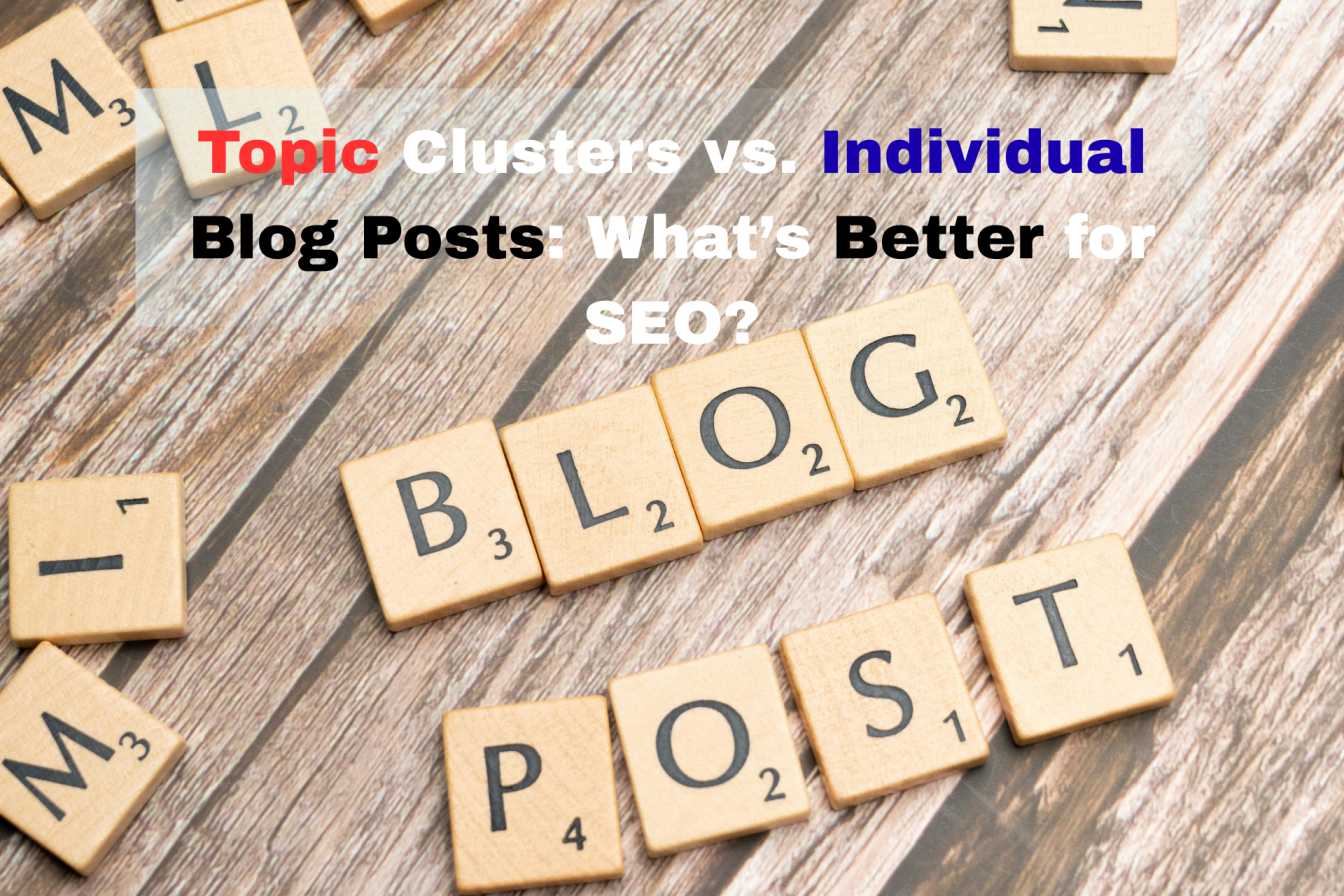Topic Clusters vs. Individual Blog Posts: What’s Better for SEO?

Search engine optimization (SEO) is no longer just about sprinkling keywords across your content. Today, it’s about structuring your content strategy in a way that search engines — and readers — can easily understand. That’s where topic clusters vs. individual blog posts come into play.
Both strategies have their merits, but which one is truly better for SEO? This article explores each approach, their advantages, when to use them, and how to leverage both for the best results.
Introduction: Why Content Strategy Matters for SEO
Content remains king in SEO, but the way you organize your content determines how effectively you can compete in search rankings. Google prioritizes topical authority and contextual relevance, rewarding sites that deliver clear, comprehensive coverage of a subject area.
This is why choosing between topic clusters and individual blog posts is such an important decision. Should you focus on creating standalone, keyword-focused articles? Or is it better to build a connected content ecosystem around a central theme?
Let’s dive in.
What Are Topic Clusters?
A topic cluster is a modern content strategy designed to improve SEO by organizing related pieces of content around a central pillar page.
At its core, a topic cluster has three components:
- Pillar Page: A comprehensive, high-level article that covers a broad topic in depth.
- Cluster Content: Supporting blog posts or pages that each cover a specific subtopic of the main theme.
- Internal Links: Hyperlinks connecting the pillar page and cluster content to signal topical relevance and hierarchy.
For example, a pillar page on “Digital Marketing” might link to cluster posts about SEO, social media, email marketing, and PPC. Each cluster post links back to the pillar page and to other relevant clusters.
This structure helps search engines understand the relationship between pieces of content and signals your authority on the topic.
What Are Individual Blog Posts?
An individual blog post is a standalone article optimized for a single keyword or topic.
These are often written to target specific, long-tail keywords and provide answers to niche queries. Unlike topic clusters, individual posts don’t always link to a broader content hub or fit into a larger strategy.
For example, a blog titled “10 Tips for Writing Meta Descriptions” could be a one-off post targeting that specific keyword without necessarily tying back to a larger SEO content strategy.
While this approach was the norm in the early days of SEO, it’s still widely used — especially by businesses with limited resources or those testing different content ideas.
Advantages of Topic Clusters
Why are topic clusters increasingly favored by SEO professionals? Here are some key benefits:
1. Improved Topical Authority
By covering a broad topic comprehensively, you demonstrate to search engines that you’re an authority in that niche. This increases the likelihood of ranking for more competitive keywords.
2. Better Internal Linking
The structured approach to internal links not only helps users navigate your site but also distributes link equity more effectively.
3. Increased Engagement
Users are more likely to explore related articles when they’re conveniently linked, increasing time on site and reducing bounce rates.
4. Future-Proof Strategy
Google’s algorithms increasingly favor topic-based authority over individual keyword optimization. Topic clusters align with this trend, making them a sustainable long-term strategy.
5. Higher Rankings for Broad Topics
Pillar pages targeting broad, competitive keywords can rank higher when supported by cluster posts targeting related, long-tail keywords.
Advantages of Individual Blog Posts
That said, individual blog posts still have a place in an effective SEO strategy. Here’s why:
1. Simplicity
They’re easier to produce, especially for small businesses or those just starting their content journey.
2. Flexibility
You can quickly target emerging trends or seasonal topics without worrying about how they fit into a larger framework.
3. Lower Resource Requirements
You don’t need to plan an entire content map; you can publish as ideas or keyword opportunities arise.
4. Faster Results
For niche topics with low competition, individual posts can rank relatively quickly.
5. Great for Testing
Individual posts allow you to test different keywords and topics to see what resonates with your audience and performs well in search.
When to Use Topic Clusters vs. Individual Blog Posts
So when should you choose topic clusters, and when do individual posts make more sense?
Use Topic Clusters When:
- You want to establish long-term topical authority.
- Your site already has some authority and you’re competing in a crowded space.
- You’re covering a complex topic with multiple subtopics.
- You have the resources to develop a comprehensive content strategy.
Use Individual Blog Posts When:
- You’re testing different keywords and topics.
- You’re targeting very specific, low-competition queries.
- Your content team is small or you have limited resources.
- You’re responding quickly to current events or trending topics.
How to Combine Both Strategies for Maximum Impact
The truth is, topic clusters and individual blog posts don’t have to be mutually exclusive. Many successful SEO strategies combine both approaches.
For example:
- Use topic clusters to dominate evergreen topics and build authority over time.
- Supplement with individual posts that target timely or highly specific queries to capture quick wins.
This hybrid approach gives you the best of both worlds — a strong foundation for long-term growth and flexibility to adapt to changing trends.
If you’re unsure how to implement this effectively, working with an experienced seo agency in calgary can help you map out a strategy tailored to your goals.
The Role of Internal Linking in SEO
No discussion of topic clusters vs. individual blog posts is complete without mentioning internal linking.
Internal links serve three critical SEO functions:
- They guide users to related content, improving user experience.
- They distribute page authority across your site.
- They help search engines discover and index more of your content.
Whether you’re building clusters or publishing individual posts, always look for opportunities to add contextual internal links. This is also an opportunity to link to your services — for example, businesses in Ontario looking for seo services in brampton can find specialized support tailored to their local market.
Final Thoughts: Which Approach Wins?
So, topic clusters vs. individual blog posts: what’s better for SEO?
The answer depends on your goals, resources, and industry. If you’re serious about establishing long-term authority and dominating competitive spaces, topic clusters are the way to go. But if you need flexibility or want to test new ideas quickly, individual posts still have a role to play.
Ideally, you should aim to use both strategies in tandem. Develop topic clusters around your most important themes, and fill gaps or capitalize on trends with individual posts.
For businesses aiming to maximize their SEO investment, consulting with an experienced seo company in Vancouver can help you craft the perfect balance of both strategies.
TL;DR: Quick Comparison Table
| Feature | Topic Clusters | Individual Blog Posts |
| Best for | Long-term authority | Quick wins |
| Internal links | Structured | Ad-hoc |
| Resource needs | Higher | Lower |
| Flexibility | Moderate | High |
| SEO impact | Strong over time | Faster short-term |
By understanding the strengths of both approaches, you can craft a content strategy that serves your audience, satisfies search engines, and achieves your business goals.
If you’d like help implementing a tailored SEO strategy that leverages both topic clusters and individual blog posts, feel free to reach out to us!



